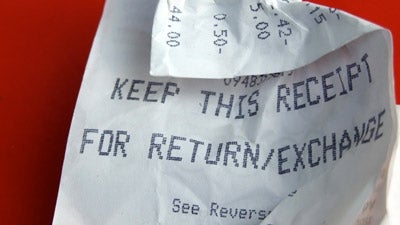
“It was OK, except for the ending.”
Have you ever heard that said about a movie? It’s a common review of movies that have great special effects, an outstanding cast and good action scenes, but mediocre endings. The last five percent of a movie can completely change a viewer’s entire experience.
Now think about your customer service experience.
You’ve built a great product and created an awesome website to represent it. You even offer phenomenal support when users need help. But when a user asks for a refund, you get emotional and stop caring. Guess which part of that experience your customer is going to remember?
We as humans have a selective memory about our experiences, as explained by the cognitive memory bias known as the “peak-end rule.” This effect suggests that people seem to perceive not the sum of an experience, but how it was at its peak, and how it ended. We often spend all of our energy making the best first impression, but pay very little attention to the end of an experience.
By optimizing our refund process, I have been able to convince dozens of customers to purchase back at a later date and become loyal customers. Here are some best practices for your own refund policy:
No-Questions-Asked Refund Policy
Often digital products advertise a 14- to 90-day, no-risk, money-back guarantee. Having a money-back guarantee like this helps with the initial conversion because it increases trust. That’s why I currently have it on all of our products. But like many others, when I first started, my refund policy wasn’t truly no-questions-asked.
When a customer requested a refund, I took it as a message that we had failed. I wanted to go above and beyond to help fix the problem. I would attempt to offer further assistance, ask how we could improve, and then give users the option of going straight to claim their refund. I thought that was pretty hassle free. Some of the users asking for refund didn’t even create a support ticket. I just wanted to help, but I was making it worse. A user shouldn’t have to justify wanting a refund.
I got three type of responses from users while using this method:
- The user would give me feedback and request a refund.
- The user would complain further, remind me that the refund policy stated “no questions asked,” and request a refund or threaten a charge-back.
- The user would accept the help and remain a customer.
From a developer’s perspective, this doesn’t sound like a broken process because I was getting some valuable feedback. Yes, I had some angry customers, but everyone has those. I was happy helping users who wanted it and remained loyal. But how do you really want your customers to remember your product? Keep in mind the peak-end effect.
Changing Our Refund Process
In order to create a memorable refund experience, I created a new workflow that truly offered a no-questions-asked refund. I made our vision clear to the entire customer support team, so that everyone was on the same page.
Now, when a user requests a refund, this response is triggered:
Hey First Name,
Thanks for reaching out. Your refund request has been assigned to our team, and upon the completion of your refund request, someone from our team will message you to confirm your refund.
Thanks for giving us a shot, and please let us know if there is any way we can serve you as a customer in the future.
Why did I use an auto-response instead of simply authorizing the refund? Not every customer-service representative has access to our payment processing accounts. During the wait time (a few minutes to a few hours), we want to stay in communication with the customer to let them know that we have received their request and are working on processing the refund. Not only does this create a better experience, but it prevents the customer from escalating the issue by creating a PayPal dispute or a charge-back with their credit card.
Once the refund is processed, we trigger the following response:
Hey First Name,
Just wanted to let you know that your payment has been refunded. If you paid with PayPal, you will see the refund in your account immediately. If you paid with a credit card, it will take anywhere between 5-10 business days for the refund to be processed on your card. We sincerely hope that you can find your way back to OptinMonster someday, and please let us know if there is any way we can improve our product to make it better!
After using this new refund process, three things happened.
- The tone of responses changed completely. There were almost no complainers. Furthermore, users expressed that they would return at a later date and recommend our product.
- The quality of feedback I got from users improved significantly.
- Users started to repurchase after trying out our competitors’ because our refund process and support convinced them to come back.
Below are some actual user responses:
- “Kudos on the great customer service.”
- “Thank you so much, you guys have fantastic service.”
- “This will sound stupid, but can you keep my account and not refund it? I tried out few other pop-ups, but your support is by far the best.”
- Thank you for your response to this. I originally purchased [competitor product] and had so many challenges integrating it and getting it to work properly, I purchased OptinMonster again last night.”
- “I have decided to keep it…How do I go about paying you again?”
Learning to Let Go
The biggest challenge you face is changing your mindset. It hurts to see a customer leave even after you tried to help them. When we used to ask questions before issuing a refund, we got some pretty ridiculous responses. People are more helpful when they’re happy. Angry customers often don’t give the most constructive feedback. By improving our refund workflow, we’ve received some very useful feedback.
We have used some of that feedback to improve our product while staying in touch with those customers. In some cases, our product is simply not the best fit for the customer. However, after improving the refund process, we have received several referrals from customers who previously requested a refund.
Refunds are not easy for anyone—including customers. Try to make your parting experience a pleasant one. Often, that’s the only thing they will remember.
A version of this post originally appeared here.
This article was syndicated from StartupCollective
Author: Syed Balki is an online marketer with design and dev skills. He creates cool sites like WPBeginner, List25, OptinMonster, SoliloquyWP, Envira Gallery and more.
Published: December 8, 2014
3184 Views
3184 Views












